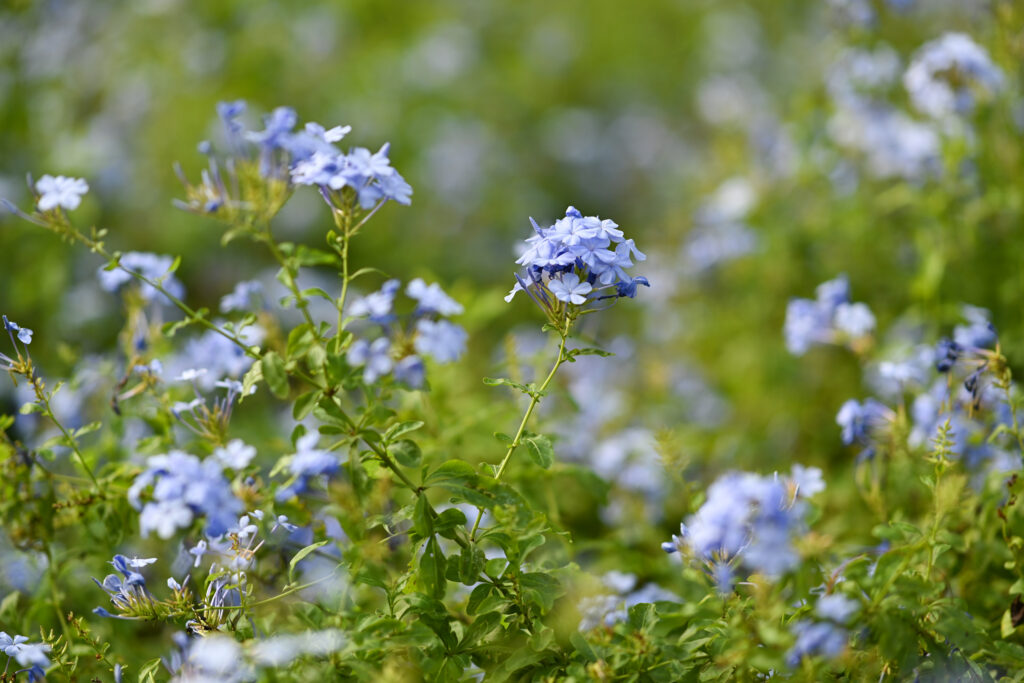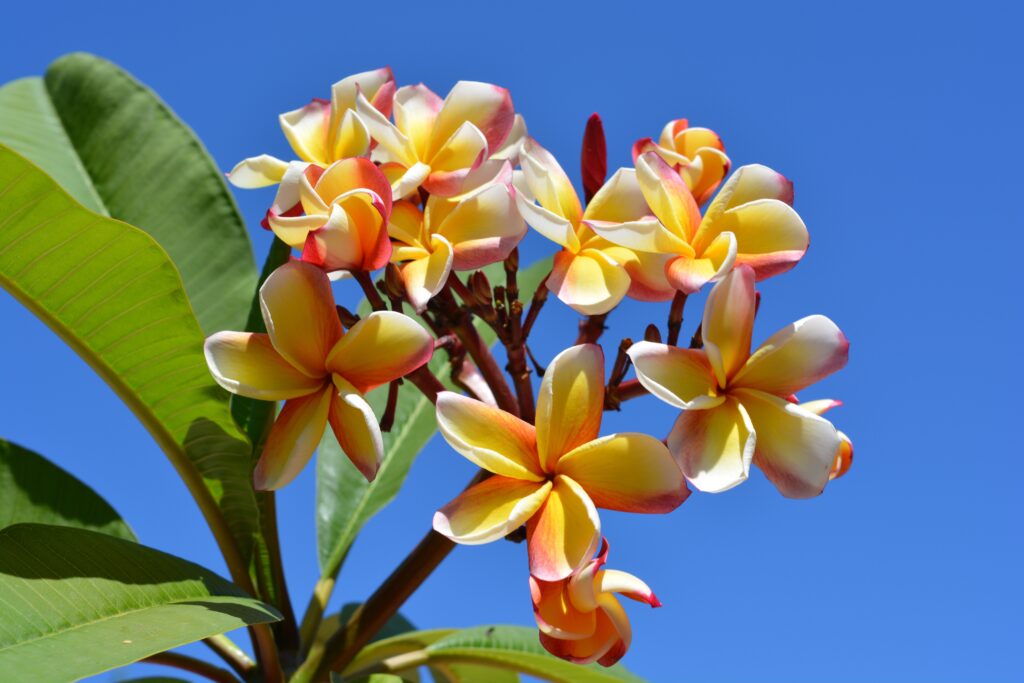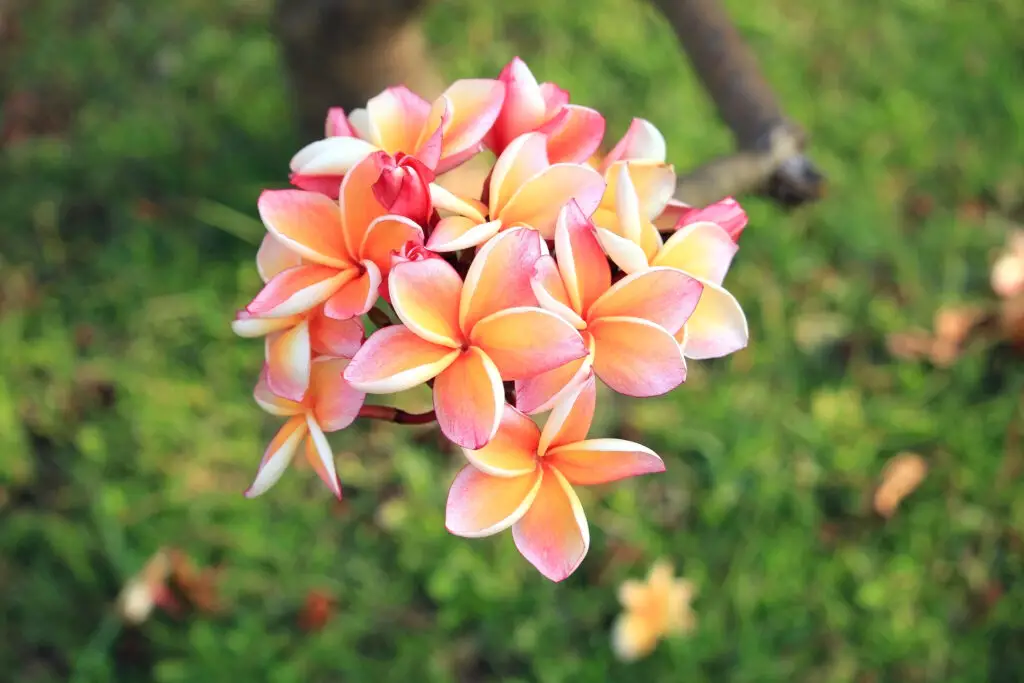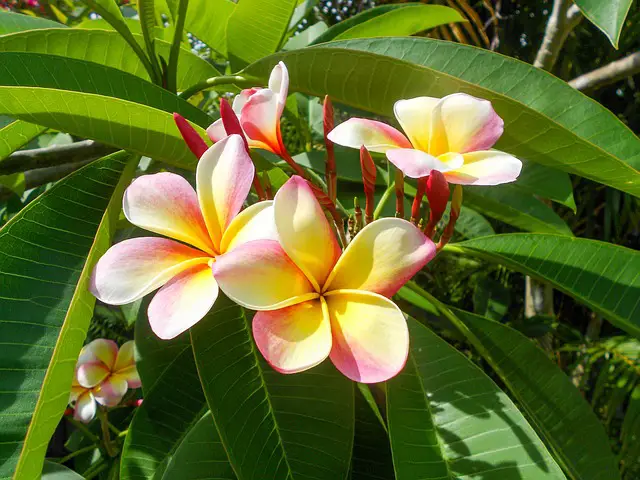Plumeria, also known as frangipani, is a popular tropical plant that is widely grown for its beautiful and fragrant flowers. However, brown spots on plumeria leaves can be a common problem that can affect the plant’s overall health and appearance.
Identifying brown spots on plumeria leaves is the first step in diagnosing the problem. Brown spots can appear as small or large dots on the leaves and can be accompanied by yellowing or browning of the leaf edges. In severe cases, the leaves may curl, become distorted, and eventually fall off the plant.
There are several causes of brown spots on plumeria leaves, including diseases and pests. Fungal diseases such as plumeria rust and black tip can cause brown spots on the leaves, while pests such as spider mites and mealybugs can also damage the leaves.
Proper diagnosis and treatment are essential in preventing the spread of the disease or pest infestation and restoring the plant’s health.
Key Takeaways on Plumeria Brown Spots on Leaves
- Brown spots on plumeria leaves can be a common problem that affects the plant’s overall health and appearance.
- Identifying brown spots is the first step in diagnosing the problem, which can be caused by diseases and pests.
- Proper diagnosis and treatment are essential in preventing the spread of the disease or pest infestation and restoring the plant’s health.
Also don’t miss:
- Philodendron Leaves Turning Yellow with Brown Spots
- Why Does My Rubber Plant Have Brown Spots?
- Philodendron Leaves Develop Brown Spots
Identifying Brown Spots on Plumeria Leaves

Plumeria plants are known for their beautiful, fragrant flowers, but they are also susceptible to brown spots on their leaves. Identifying these brown spots is the first step in treating the problem.
Symptoms
The first symptom of brown spots on plumeria leaves is the appearance of yellow specks on the top part of the leaves. These specks will later turn into brown or gray until the leaves totally wither. If you check underneath your plant’s leaves, you will see countless yellow-orange powdery lesions.
Common Problems
There are a few common problems that can cause brown spots on plumeria leaves.
Fungal Diseases
One of the most common problems is fungal diseases, such as plumeria rust, powdery mildew, black tip fungus, and sooty mold. Plumeria rust is characterized by yellow specks or spots on the upper sides of the leaves, and powdery orange lesions on the underside of the leaves.
Powdery mildew appears as a white or gray powdery substance on the leaves, while black tip fungus causes black tips on the leaves. Sooty mold appears as a black, sooty substance on the leaves.
Too Much Sunlight
Another common problem that can cause brown spots on plumeria leaves is too much sunlight. Plumeria plants need full sun to partial shade to produce the best possible blooms, but too much sun, especially during the day’s hottest hours, can cause the leaves to develop brown spots.
Causes of Brown Spots
Plumeria leaves can develop brown spots due to various reasons. The most common causes of brown spots on Plumeria leaves are fungal diseases, pest infestation, and environmental factors.
1. Fungal Diseases
Fungal diseases are a common cause of brown spots on Plumeria leaves. Plumeria Rust, caused by the fungus Coleosporium plumeriae, is the most common fungal disease that affects Plumeria plants.
The disease is characterized by the appearance of brown spots on the leaves, which gradually turn black and cause the leaves to fall off. Other fungal diseases that can cause brown spots on Plumeria leaves include powdery mildew and black spot.
2. Pest Infestation

Pest infestation is another common cause of brown spots on Plumeria leaves. Mealybugs, spider mites, and scale insects are the most common pests that attack Plumeria plants.
These pests can cause brown spots on the leaves, which can eventually lead to leaf drop. Regular inspection and treatment with insecticides can help prevent pest infestation.
3. Environmental Factors
Environmental factors such as air, rain, sunlight, humidity, overwatering, underwatering, drought, and sunburn can also cause brown spots on Plumeria leaves. Too much or too little water, exposure to extreme temperatures, and lack of nutrients can weaken the plant and make it more susceptible to diseases and pests.
Plumeria plants need full sun to partial shade to produce the best possible blooms, but too much sun, especially during the day’s hottest hours, can cause the leaves to develop brown spots.
In conclusion, brown spots on Plumeria leaves can be caused by various factors, including fungal diseases, pest infestation, and environmental factors. Regular inspection, proper watering, and timely treatment can help prevent and control brown spots on Plumeria leaves.
Types of Diseases and Pests
Plumeria plants are susceptible to various diseases and pests that can cause brown spots on their leaves. In this section, we will discuss the most common types of diseases and pests that affect plumeria plants and how to identify and treat them.
Plumeria Rust
Plumeria rust is a fungal disease caused by Coleosporium plumeriae that affects the leaves of plumeria plants. It appears as yellow-orange spots on the top of the leaves and brown, powdery pustules on the underside of the leaves. The disease spreads rapidly during the rainy season and can cause defoliation if left untreated.
To treat plumeria rust, remove the infected leaves and destroy them. Spray the plant with a fungicide that contains copper or mancozeb. Ensure that the plant has good air circulation and avoid overhead watering.
Black Tip Fungus

Black tip fungus is another fungal disease that affects plumeria plants. It appears as black spots on the tips of the leaves, which eventually turn brown and fall off. The fungus spreads rapidly during the rainy season and can cause defoliation if left untreated.
To treat black tip fungus, remove the infected leaves and destroy them. Spray the plant with a fungicide that contains copper or mancozeb. Ensure that the plant has good air circulation and avoid overhead watering.
Insect Infestations
Plumeria plants are also susceptible to various insect infestations that can cause brown spots on their leaves. Some common insects that affect plumeria plants include spider mites, mealybugs, scale insects, nematodes, whiteflies, and leafhoppers.
To treat insect infestations, use a systemic insecticide that contains imidacloprid or dinotefuran. Ensure that the plant has good air circulation and avoid over-fertilizing the plant, which can attract insects.
Diagnosis and Treatment
Plumeria leaves with brown spots can indicate a fungal infection or pest infestation. It is important to properly diagnose the cause of the brown spots in order to provide the appropriate treatment.
Fungal Infection Treatment
If the brown spots on Plumeria leaves are due to a fungal infection, the best course of action is to use a fungicide. There are several types of fungicides available, including copper-based and systemic fungicides. Copper-based fungicides can be effective in treating Plumeria rust, a common fungal infection in Plumeria plants.
Systemic fungicides, such as those containing azoxystrobin or propiconazole, can be used to treat a wider range of fungal infections. It is important to follow the instructions on the fungicide label carefully and apply it as directed.
In addition to using fungicides, it is also important to remove any infected leaves and dispose of them properly. This can help prevent the spread of the fungus to other parts of the plant or to other plants in the area.
Pest Control

If the brown spots on Plumeria leaves are due to a pest infestation, there are several options for pest control. Insecticidal soap and horticultural oil can be effective in controlling pests such as aphids and spider mites.
Neem oil is another option that can be effective against a wide range of pests, including aphids, spider mites, and whiteflies. Pesticides may also be used to control pests, but it is important to choose a product that is labeled for use on Plumeria plants and to follow the instructions carefully.
It is also important to monitor the plant regularly for signs of pest infestation and to take action as soon as possible to prevent the pests from causing significant damage to the plant. Regular pruning can also help to remove any infected or damaged leaves and promote healthy growth.
Preventive Measures
To prevent brown spots on plumeria leaves, there are several preventive measures that can be taken. Proper watering, adequate sunlight, air circulation and spacing, regular pruning, and appropriate fertilization are all key factors in keeping plumerias healthy and free from brown spots.
1. Proper Watering
Overwatering or underwatering can both lead to brown spots on plumeria leaves. Plumerias prefer well-draining soil, so it is important to make sure the soil is not too moist or too dry.
When watering, it is best to water deeply and then allow the soil to dry out before watering again. This will help prevent overwatering and ensure adequate drainage.
2. Adequate Sunlight
Plumerias need full sun to partial shade to produce the best possible blooms, but too much sun, especially during the day’s hottest hours, can cause the leaves to develop brown spots. Make sure to provide adequate shade during the hottest parts of the day to prevent sunburn and brown spots.
3. Air Circulation and Spacing

Good air circulation is important for preventing fungal diseases that can cause brown spots on plumeria leaves. Make sure to space plumerias out properly to allow for good air circulation. Avoid overcrowding and make sure there is enough space between plants.
4. Regular Pruning
Regular pruning can help prevent brown spots on plumeria leaves by removing infected or damaged leaves and improving air circulation. Make sure to prune plumerias regularly to remove dead or diseased branches and leaves.
5. Appropriate Fertilization
Plumerias need regular fertilization to produce healthy blooms, but too much fertilizer or the wrong type of fertilizer can lead to brown spots on the leaves. Use a balanced fertilizer specifically designed for plumerias, and follow the recommended application rates.
Overfertilization can lead to fertilizer burn and brown spots on the leaves.
Resistant Varieties and Care
Resistant Plumeria Varieties
While there is no known cure for Plumeria rust, some varieties of Plumeria plants have shown resistance to the disease. According to a study by the University of Hawaii, Plumeria stenopetala and Plumeria caracasana have shown the most resistance to rust fungus so far.
These varieties are worth considering if you live in an area where Plumeria rust is prevalent.
General Plumeria Care
In addition to planting resistant varieties, proper care is essential to keep your Plumeria plants healthy and prevent the spread of rust. Here are some general care tips to keep in mind:
- Watering: Plumeria plants are drought-tolerant and do not require frequent watering. Overwatering can lead to root rot and other problems. Water your Plumeria plants deeply only when the soil is dry to the touch.
- Fertilizing: Plumeria plants require regular fertilization during the growing season. Use a balanced fertilizer with a higher phosphorus content to promote flowering. Avoid using too much nitrogen, as this can lead to lush foliage but fewer flowers.
- Pruning: Prune your Plumeria plants regularly to promote healthy growth and prevent overcrowding. Remove any dead or diseased branches, as these can attract pests and diseases. Prune your plants in late winter or early spring, before new growth appears.
- Pest Control: Plumeria plants are susceptible to a variety of pests, including spider mites, leafhoppers, and ants. Use a mild insecticidal soap to control these pests. Avoid using harsh chemicals, as these can damage your plants and harm beneficial insects.
- Sunlight: Plumeria plants require full sun to partial shade to produce the best possible blooms. However, too much sun, especially during the day’s hottest hours, can cause the leaves to develop brown spots. Make sure your plants are getting the right amount of sunlight for their needs.
Final Thoughts

Brown spots on plumeria leaves can be caused by a variety of factors, including fungal infections, overexposure to sunlight, and poor soil conditions. It is important to identify the cause of the brown spots early on to prevent further damage to the plant.
One of the most effective ways to prevent brown spots on plumeria leaves is to ensure that the plant is receiving the proper amount of sunlight and water.
Plumeria plants need full sun to partial shade to produce the best possible blooms, but too much sun, especially during the day’s hottest hours, can cause the leaves to develop brown spots. Additionally, overwatering can lead to root rot, which can also cause brown spots on the leaves.
If brown spots do appear on the leaves, it is important to act quickly to prevent the spread of the infection. This can be done by removing the affected leaves and treating the plant with a fungicide.
There are both cultural and chemical control methods available for treating plumeria rust, so it is important to choose the method that is best suited for your particular situation.
Frequently Asked Questions
What causes rust spots on plumeria leaves?
Rust spots on plumeria leaves are caused by a fungal disease called Plumeria rust. The disease is caused by the fungus Coleosporium plumeriae, which infects the leaves of the plant. The fungus thrives in warm, humid conditions and can spread quickly, causing brown spots on the leaves.
How do you get rid of rust fungus on plumeria?
To get rid of rust fungus on plumeria, it is important to remove all infected leaves and dispose of them properly. Fungicides can also be used to treat the disease, but it is important to follow the instructions carefully to avoid damaging the plant.
Good cultural practices, such as avoiding overhead watering and providing proper air circulation, can also help prevent the disease from spreading.
What do overwatered plumeria leaves look like?
Overwatered plumeria leaves may appear yellow and wilted, with brown spots on the edges. The leaves may also feel soft and mushy to the touch. Overwatering can lead to root rot and other fungal diseases, so it is important to water the plant only when the soil is dry.
Why are my plumeria leaves turning yellow with brown spots?
Plumeria leaves may turn yellow with brown spots due to a variety of factors, including overwatering, underwatering, nutrient deficiencies, and fungal diseases. It is important to identify the underlying cause of the problem to properly treat the plant.
What is the treatment for plumeria rust?
The treatment for plumeria rust includes removing all infected leaves and disposing of them properly. Fungicides can also be used to treat the disease, but it is important to follow the instructions carefully to avoid damaging the plant.
Good cultural practices, such as avoiding overhead watering and providing proper air circulation, can also help prevent the disease from spreading.
How can I prevent plumeria disease?
To prevent plumeria disease, it is important to provide the plant with proper care, including regular watering, fertilization, and pruning.
Good cultural practices, such as avoiding overhead watering and providing proper air circulation, can also help prevent fungal diseases. It is also important to monitor the plant for signs of disease and treat it promptly if any issues arise.

Hey, I’m Lisa and I’ve been an avid gardener for over 30 years. I love writing, talking and living in the garden! Feel free to connect with me on my socials below


